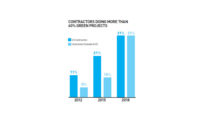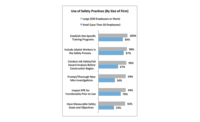The most telling finding—the one which demonstrates that owners who can leverage BIM for FM are generally more engaged with BIM—is the high percentage (62%) who report they have well-developed guidelines for BIM. That's much higher than the 35% of those who are less capable of leveraging BIM for FM.
This finding is important because it suggests that these owners recognize the need to guide the industry to ensure that the final model contains the information they need. For an owner to best take advantage of BIM for FM, architects and contractors must create models with that goal in mind, as well as the needs of the design and construction process. In fact, in some cases, it is likely that owners may be more capable of leveraging BIM in FM because they have strict guidelines in place for their design and construction team to help them do so.
Benefits of BIM Use
This higher level of BIM engagement may also enable owners who can leverage BIM for FM to be more aware of the benefits of using BIM for design and construction. In fact, two-thirds (66%) find that BIM reduces construction costs. That's double the percentage of those with fewer capabilities to leverage BIM for FM (33%).
A significantly higher percentage also finds that BIM reduces their construction schedule and provides them with a more well-rounded design. And while the difference is not statistically significant, a notably higher percentage (62%) who can leverage BIM for FM see that BIM reduces problems during construction, compared with the 49% who have less capability for that.
Owners Who Require BIM
Given the greater awareness of BIM's benefits, it's not surprising that 41% of the owners who can leverage BIM for FM require it on their projects, compared with just 17% who cannot. Not only are they capable of drawing value from BIM throughout the project life cycle, but their greater knowledge and engagement with BIM also allows them to perceive more clearly its benefits during construction.
One last finding demonstrates the longer-term implications of this trend: Nearly all U.S. owners (90%) believe that by 2019, BIM will offer at least moderate value for the operation of buildings, a dramatic growth over the 61% who believe it currently does. This strongly suggests that owners expect BIM tools to improve enough to extract more value across the life of the building from models created during design and construction.
If that expectation holds true, then contractors can expect to see a significant growth in the number of owners with specific BIM guidelines and growth in the number of owners who will require BIM use on their projects. This trend offers an opportunity for contractors who can proactively demonstrate their knowledge of BIM to potential clients.
However, knowledge of how to improve construction processes may not be enough to truly gain a competitive edge. Instead, construction companies can work with owners to create models that have value throughout the building life cycle. Those firms may be the ones that build the strongest and most lasting relationships with clients, creating repeat business and distinguishing themselves from their competitors.






Post a comment to this article
Report Abusive Comment